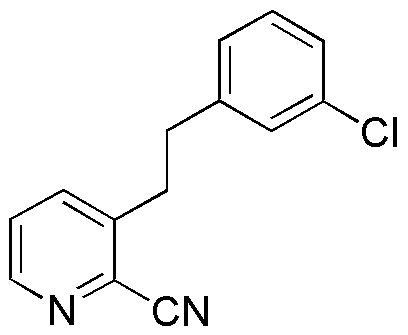2-Cyano-3-(3-chlorophenylethyl)pyridine is widely utilized in research focused on
- Pharmaceutical Development: This compound serves as a key intermediate in the synthesis of various pharmaceuticals, particularly those targeting neurological disorders. Its unique structure allows for modifications that enhance therapeutic efficacy.
- Agricultural Chemicals: It is used in the formulation of agrochemicals, acting as a precursor for developing pesticides and herbicides. This application helps improve crop yield and pest resistance, benefiting farmers and agricultural industries.
- Material Science: The compound finds applications in creating advanced materials, such as polymers and coatings, that require specific chemical properties for durability and performance, making it valuable in manufacturing sectors.
- Biochemical Research: Researchers utilize this compound to study its interactions with biological systems, aiding in the discovery of new biochemical pathways and potential drug targets, which is crucial for advancing medical research.
- Analytical Chemistry: It is employed in analytical methods to detect and quantify other compounds, providing essential data for quality control in various industries, including food and pharmaceuticals.
General Information
Properties
Safety and Regulations
Applications
2-Cyano-3-(3-chlorophenylethyl)pyridine is widely utilized in research focused on
- Pharmaceutical Development: This compound serves as a key intermediate in the synthesis of various pharmaceuticals, particularly those targeting neurological disorders. Its unique structure allows for modifications that enhance therapeutic efficacy.
- Agricultural Chemicals: It is used in the formulation of agrochemicals, acting as a precursor for developing pesticides and herbicides. This application helps improve crop yield and pest resistance, benefiting farmers and agricultural industries.
- Material Science: The compound finds applications in creating advanced materials, such as polymers and coatings, that require specific chemical properties for durability and performance, making it valuable in manufacturing sectors.
- Biochemical Research: Researchers utilize this compound to study its interactions with biological systems, aiding in the discovery of new biochemical pathways and potential drug targets, which is crucial for advancing medical research.
- Analytical Chemistry: It is employed in analytical methods to detect and quantify other compounds, providing essential data for quality control in various industries, including food and pharmaceuticals.
Documents
Safety Data Sheets (SDS)
The SDS provides comprehensive safety information on handling, storage, and disposal of the product.
Product Specification (PS)
The PS provides a comprehensive breakdown of the product’s properties, including chemical composition, physical state, purity, and storage requirements. It also details acceptable quality ranges and the product's intended applications.
Certificates of Analysis (COA)
Search for Certificates of Analysis (COA) by entering the products Lot Number. Lot and Batch Numbers can be found on a product’s label following the words ‘Lot’ or ‘Batch’.
Numéro de catalogue
Numéro de lot/série
Certificates Of Origin (COO)
This COO confirms the country where the product was manufactured, and also details the materials and components used in it and whether it is derived from natural, synthetic, or other specific sources. This certificate may be required for customs, trade, and regulatory compliance.
Numéro de catalogue
Numéro de lot/série
Safety Data Sheets (SDS)
The SDS provides comprehensive safety information on handling, storage, and disposal of the product.
DownloadProduct Specification (PS)
The PS provides a comprehensive breakdown of the product’s properties, including chemical composition, physical state, purity, and storage requirements. It also details acceptable quality ranges and the product's intended applications.
DownloadCertificates of Analysis (COA)
Search for Certificates of Analysis (COA) by entering the products Lot Number. Lot and Batch Numbers can be found on a product’s label following the words ‘Lot’ or ‘Batch’.
Numéro de catalogue
Numéro de lot/série
Certificates Of Origin (COO)
This COO confirms the country where the product was manufactured, and also details the materials and components used in it and whether it is derived from natural, synthetic, or other specific sources. This certificate may be required for customs, trade, and regulatory compliance.


